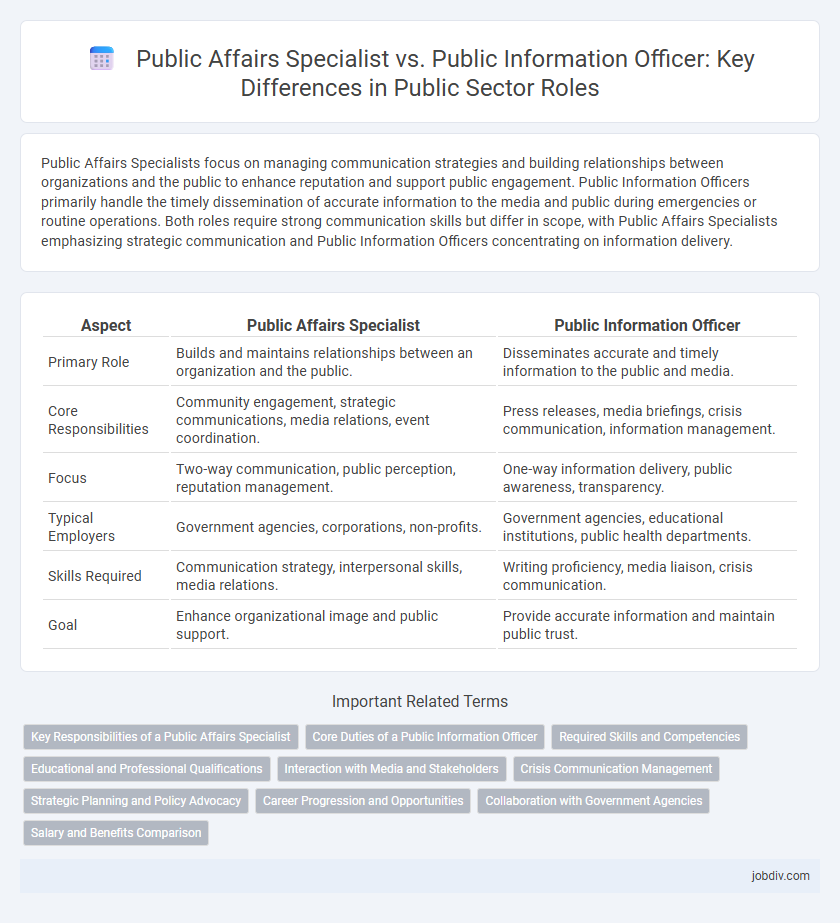Public Affairs Specialists focus on managing communication strategies and building relationships between organizations and the public to enhance reputation and support public engagement. Public Information Officers primarily handle the timely dissemination of accurate information to the media and public during emergencies or routine operations. Both roles require strong communication skills but differ in scope, with Public Affairs Specialists emphasizing strategic communication and Public Information Officers concentrating on information delivery.
Table of Comparison
| Aspect | Public Affairs Specialist | Public Information Officer |
|---|---|---|
| Primary Role | Builds and maintains relationships between an organization and the public. | Disseminates accurate and timely information to the public and media. |
| Core Responsibilities | Community engagement, strategic communications, media relations, event coordination. | Press releases, media briefings, crisis communication, information management. |
| Focus | Two-way communication, public perception, reputation management. | One-way information delivery, public awareness, transparency. |
| Typical Employers | Government agencies, corporations, non-profits. | Government agencies, educational institutions, public health departments. |
| Skills Required | Communication strategy, interpersonal skills, media relations. | Writing proficiency, media liaison, crisis communication. |
| Goal | Enhance organizational image and public support. | Provide accurate information and maintain public trust. |
Key Responsibilities of a Public Affairs Specialist
A Public Affairs Specialist manages strategic communication efforts to promote organizational goals, craft messaging for diverse stakeholder engagement, and handle media relations and community outreach. They develop and implement public information campaigns, monitor public opinion, and advise leadership on communication strategies to enhance reputation and transparency. Their role also includes coordinating events, writing press releases, and ensuring consistent messaging across various platforms.
Core Duties of a Public Information Officer
A Public Information Officer (PIO) primarily manages communication between government agencies and the public, ensuring accurate dissemination of information during emergencies and routine government operations. Core duties include crafting press releases, coordinating media briefings, and monitoring public sentiment to maintain transparency and trust. Unlike a Public Affairs Specialist, who focuses on strategic messaging and policy advocacy, the PIO's role centers on timely, clear, and factual public communication.
Required Skills and Competencies
Public Affairs Specialists require strong strategic communication skills, media relations expertise, and the ability to develop comprehensive outreach campaigns, emphasizing message crafting and stakeholder engagement. Public Information Officers must excel in crisis communication, information dissemination, and maintaining transparent public records, with a focus on rapid response and clarity under pressure. Both roles demand proficiency in social media management, content creation, and government regulations, but Public Affairs Specialists prioritize long-term public perception, while Public Information Officers concentrate on timely, accurate public updates.
Educational and Professional Qualifications
Public Affairs Specialists typically possess a bachelor's degree in communications, journalism, public relations, or political science, often supplemented with specialized training in media relations and community engagement. Public Information Officers usually require a similar educational background but may also hold certifications from organizations such as the Public Relations Society of America (PRSA) or the International Association of Business Communicators (IABC), emphasizing skills in crisis communication and government outreach. Both roles benefit from experience in public sector environments, but Public Affairs Specialists often have advanced expertise in policy analysis and stakeholder communication.
Interaction with Media and Stakeholders
Public Affairs Specialists engage proactively with media and stakeholders by crafting strategic communication plans and facilitating dialogue to shape public perception and support organizational goals. Public Information Officers primarily focus on disseminating accurate and timely information, responding to media inquiries, and managing press releases to ensure transparency and trust. Both roles require strong media relations skills, but Public Affairs Specialists emphasize influence and engagement, whereas Public Information Officers prioritize clear and factual communication.
Crisis Communication Management
Public Affairs Specialists focus on strategic communication planning and stakeholder engagement, while Public Information Officers prioritize timely information dissemination and media relations during crises. In crisis communication management, Public Information Officers act as primary spokespersons to provide accurate updates and manage public perception. Effective coordination between both roles ensures consistent messaging and rapid response to evolving situations.
Strategic Planning and Policy Advocacy
Public Affairs Specialists excel in strategic planning by developing long-term communication campaigns that align with organizational goals and influence public opinion. Public Information Officers primarily focus on policy advocacy through timely dissemination of accurate information to media and stakeholders, ensuring transparency and compliance with regulations. Both roles require strong coordination skills, but Public Affairs Specialists emphasize proactive strategy while Public Information Officers prioritize reactive information management.
Career Progression and Opportunities
Public Affairs Specialists often have broader career progression opportunities in strategic communication roles within government, corporate, or nonprofit sectors, focusing on policy advocacy, stakeholder engagement, and media relations. Public Information Officers typically advance within public agencies or organizations, specializing in disseminating information to the public and managing crisis communications, often transitioning into senior communication management positions. Both roles require strong communication skills, but Public Affairs Specialists may have a wider range of leadership opportunities due to their involvement in policy shaping and public engagement strategies.
Collaboration with Government Agencies
A Public Affairs Specialist coordinates with government agencies to develop strategies that effectively communicate policies and programs to the public. Public Information Officers serve as primary points of contact, facilitating timely information flow between government entities and the media. Both roles require strong collaboration skills to ensure accurate and consistent messaging across all government platforms.
Salary and Benefits Comparison
Public Affairs Specialists typically earn a median salary of $65,000 annually, while Public Information Officers earn slightly higher, around $70,000 per year, reflecting their broader role in communication strategy. Benefits for both positions commonly include health insurance, retirement plans, and paid leave, though Public Information Officers may receive additional perks such as professional development opportunities and higher overtime pay. Salary variations depend on government level, location, and years of experience in public communication fields.
Public Affairs Specialist vs Public Information Officer Infographic

 jobdiv.com
jobdiv.com